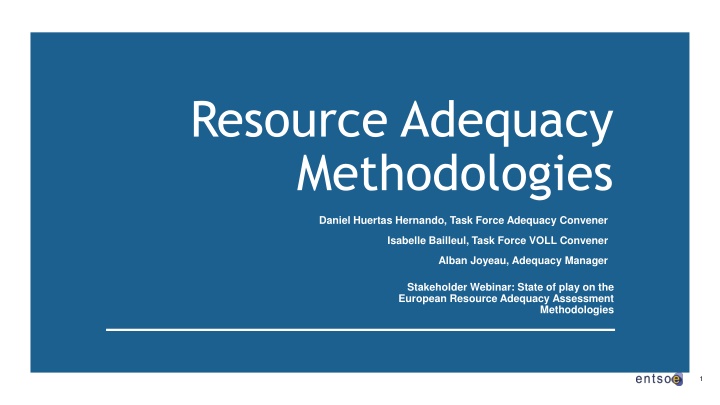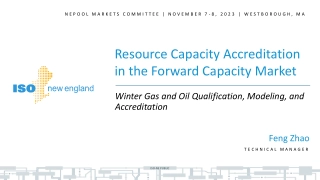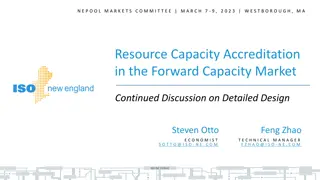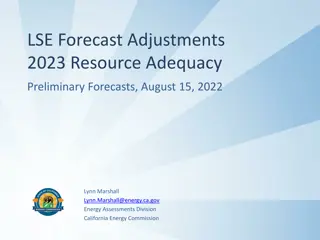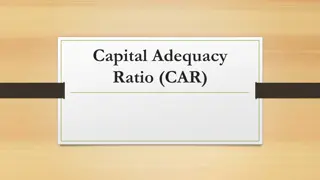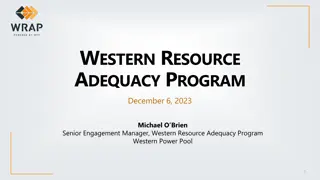European Resource Adequacy Assessment Methodologies Overview
European Resource Adequacy Assessment Methodologies cover Cost of New Entry (CONE), Value of Lost Load (VOLL), Reliability Standard, and more. The timeline outlines key events in methodology development. Public consultation respondents include various stakeholders like IFIEC Europe, EDF, and wind energy associations.
Download Presentation

Please find below an Image/Link to download the presentation.
The content on the website is provided AS IS for your information and personal use only. It may not be sold, licensed, or shared on other websites without obtaining consent from the author.If you encounter any issues during the download, it is possible that the publisher has removed the file from their server.
You are allowed to download the files provided on this website for personal or commercial use, subject to the condition that they are used lawfully. All files are the property of their respective owners.
The content on the website is provided AS IS for your information and personal use only. It may not be sold, licensed, or shared on other websites without obtaining consent from the author.
E N D
Presentation Transcript
Resource Adequacy Methodologies Daniel Huertas Hernando, Task Force Adequacy Convener Isabelle Bailleul, Task Force VOLL Convener Alban Joyeau, Adequacy Manager Stakeholder Webinar: State of play on the European Resource Adequacy Assessment Methodologies 1
2 Agenda Cost of New Entry methodology (CONE) 1 1 4 4 Welcome and introduction European Resource Adequacy Assessment methodology (ERAA) Reliability Standard methodology (RS) 2 2 5 5 Value of Lost Load methodology (VOLL) Next steps on methodologies and conclusions 3 3 6 6 7 7 Questions/Answers 2
Resource adequacy methodologies Timeline 2019 2020 Dec Jan Feb Mar Apr May Jun Jul Aug Sep Methodology update Resource adequacy ENTSO-E consultation & approval methodologies Public stakeholder workshop on draft methodologies Public Consultation Webinar on public consultation comments and ENTSO-E replies Methodology submission ACER s Approval to ACER ERAA Methodology Voll, CONE & Reliability Standard Methodology Approved methodology Methodology submission to ACER Public workshops 4
European Resource Adequacy Assessment - Public consultation respondent summary List of responding organizations Representation of responding organizations* Anonymity requested IFIEC Europe Other Ministry for Economic Affairs, Innovation, Digitalization and Energy of the State of North Rhine- Westphalia (MWIDE) Anonymity requested Consumers ClientEarth Generators Danish Energy Agency National Grid ESO DSOs EDF Naturgy TSOs / RSCs rsted Bioenergy & Thermal Power A/S Enel NRA ENGIE Regulatory Assistance Project Ministry/ Competent Authority Eurelectric smartEn - Smart Energy Europe Union of the French Electricity industry (UFE) FEBEG 0 5 10 15 Number of respondents Iberdrola, S.A. WindEurope The category Other includes, inter alia, suppliers/traders (4), sector associations (4) and NGOs (2). A total of 19 stakeholders participated to the public consultation on the ERAA methodology. 5 * Some respondents categorised them as representing multiple groups so the chart sums to more than 19 respondents
VoLL, CONE and Reliability Standard - Public consultation respondent summary List of responding organizations Representation of responding organizations* Heriot-Watt University, University of Edinburgh Anonymity requested Other Anonymity requested IFIEC Europe Consumers ClientEarth Naturgy Generators rsted Bioenergy & Thermal Power A/S DSOs EDF TSOs / RSCs Enel The Danish Energy Agency NRA ENGIE Total Direct Energie Ministry/ Competent Authority Union of the French Electricity industry (UFE) Eurelectric 0 2 4 6 8 10 12 Number of respondents FEBEG The category Other includes, inter alia, suppliers/traders (5), a sector association (1), an NGO (1), an academic (1). A total of 15 stakeholders participated to the public consultation on the methodology for calculating the VoLL, CONE and Reliability Standard. 6 * Some respondents categorised them as representing multiple groups so the chart sums to more than 15 respondents
2. European Resource Adequacy Assessment methodology (ERAA) 7
ERAA Main topic #1 Data and transparency Stakeholders comment Regarding the use and accessibility of data: Many stakeholders request the publication of input datasets and assumptions. Some would even like to see the publication of market models that where used. Others stress the importance to protect commercially sensitive data (e.g. unit-by-unit thermal generators). ENTSO-E position ENTSO-E is constantly working towards improved models that build on clear and transparent assumptions and input datasets. Most of the data used are already published with our reports. Some information (e.g. thermal power plant locations with techno-economic parameters) is commercially sensitive and their publication is constrained by confidentiality considerations. 8
ERAA Main topic #2 Contribution of balancing reserves (FCR, FRR, RR) Stakeholders comment Regarding balancing reserves, ENTSO-E has received conflicting comments: Some stakeholders support the consideration / use of all balancing reserves as being available to prevent adequacy issues. Other stakeholders state that all balancing reserves should be excluded from solving adequacy issues. ENTSO-E position ENTSO-E supports the view that balancing reserves (FCR and FRR) should not be used for adequacy, for reasons explained in the methodology document. FCR and FRR resources are subtracted from the available generation, as was the case in the past with the Mid-term Adequacy Forecast. Replacement Reserves (RR), on the other hand, are optional and only used to replace the FRR. RR are considered available in ERAA to solve adequacy issues. And keeping RR aside (e.g. not use them to solve adequacy) would be considered as too conservative assumption. 9
ERAA Main topic #3 Modelling of strategic reserves Stakeholders comment Strategic reserves should be considered in the main assessment with capacity mechanisms, as: Strategic reserves can be considered to be part of capacity mechanisms. Excluding strategic reserves from the main assessment with capacity mechanisms therefore poses a contradiction. In addition, even if out of the market, strategic reserves contribute to adequacy. ENTSO-E position We acknowledge the stakeholder feedback on strategic reserves. Strategic reserves will be considered in the scenario with capacity mechanisms, whenever feasible and under a specific framework. The methodology was updated accordingly. 10
ERAA Main topic #4 Interconnections Stakeholders comment The methodology should consider real network development (projects in the development phase only) as stated in the electricity regulation. This is currently not reflected in the methodology, which states that the methodology should be in line with projects listed in TYNDP. ENTSO-E position Network planning is a separate scope from the ERAA. This is a well-established process within the TYNDP project. The TYNDP outputs will be used by the ERAA in an effort to align assumptions and scenarios with respect to expectations on new projects' commissioning and the status of the grid. ENTSO-E's position is that projects that are officially planned to be commissioned within the time horizon of an ERAA assessment shall be considered in the corresponding years and in line with the TYNDP listed projects. If this is not the case, then the assessment tends to be unrealistically conservative. 11
ERAA Main topic #5 Consultation on scenarios, input data & assumptions Stakeholders comment ENTSO-E should hold an additional consultation phase on the data and scenarios, before the assessment takes place. That way, assumptions and input data can be exposed to the community of stakeholders for feedback. In addition, comments show that stakeholders are aware of the need for alignment of scenarios of TYNDP/Scenario Building. ENTSO-E position ENTSO-E will strive use the most up-to-date possible data in each adequacy assessment. ENTSO-E will hold a public consultation at the publication of each ERAA report and eventually consider and respond to stakeholder comments for the improvement of future studies. ENTSO-E will also publish assumptions of each ERAA in parallel to the assessment (a full sequential approach is not feasible as it would lead to a duration of at least 18 months for each ERAA). ENTSO-E will maintain regular communication with stakeholder through workshops and webinars, in close cooperation with ACER. 12
ERAA Main topic #6 Economic Viability Stakeholders comment Economic viability has received various stakeholder comments and proposals: The methodology should define a clear criterion for retirement, mothballing and investment decisions. The economic viability model should consider the possibility of units moving from policy to non-policy. ENTSO-E should add extra checks on the applicability of planned CMs considering legislative restrictions such as the Emission Performance Standard of 550 g CO2/kWh. ENTSO-E position It was clarified in the ERAA methodology that the main criterion for the economic viability assessment is the minimization of the overall system cost, including operational and investment costs. Also risk-aversion will be considered within economic viability checks. We explicitly added the possibility of a policy-driven asset to change its status to non-policy. Regarding applicability of CMs, the text is modified in order to consider further legislative restrictions. 13
ERAA Main topic #7 DSR representation Stakeholders comment Explicit and implicit demand-side response (DSR) should be clearly separated in the methodology. Additional explanations on how explicit and implicit DSR will be modelled should be provided, as DSR is seen as a key ingredient of future power systems in order to balance increasingly variable generation patterns. A consistent, European-wide applicable methodology is desired to estimate DSR potential and its evolution across market zones. ENTSO-E position ENTSO-E position DSR resources receive increasing attention. The rising availability of digital services and time-differentiated tariff options may grow the use of DSR in the near future. We agree with the stakeholder on the importance of demand-side response (DSR) in adequacy studies. We therefore aim to improve the way DSR is incorporated in our models. Different product definitions and techno-economic assumptions make a consistent European-wide assessment of DSR currently highly challenging. ENTSO-E will continue to work towards improved estimations of explicit and implicit demand flexibility in future MAF/ERAA studies. 14
ERAA Main topic #8 Inclusion of climate change effects Stakeholders comment The methodology should reflect climate change in input data and modelling, especially in the context of the Pan- European Climate Database (PECD) currently in use. Some stakeholders doubt that the current database is fit for purpose to model the future climate evolution. Other stakeholders request more information on how such effects will be modelled in future studies. ENTSO-E position ENTSO-E is aware that historical climate data may be insufficient to assess future conditions modelled within studies such as ERAA. ENTSO-E is currently seeking ways to incorporate effects of climate change in its respective databases within a dedicated taskforce. Modelling such effects is not straightforward and needs careful analysis and testing, given the various scenarios of future climate resulting from different global circulation models, spatial downscaling methods and their uncertainties as well as the transformation of aggregated, annual values into hourly time series. ENTSO-E envisions to model such effects in future ERAA publications after passing a proof-of-concept phase. 15
ERAA Main topic #9 Implementation roadmap Stakeholders comment ENTSO-E should provide an accompanying timeline as a means to transparently communicate about the gradual implementation of the ERAA and the commitments ENTSO-E is willing to take with regard to the timing of the different implementation steps. Such a timeline would be considered useful to complement Article 9 of the methodology on the envisaged adequacy assessment process. ENTSO-E position ENTSO-E acknowledges the need for an implementation roadmap: ENTSO-E is planning to publish a roadmap on its website. This roadmap might be updated during the implementation phase due to the additional complexity of some features of the ERAA methodology, based on the experience gained from internal exercises and proof-of-concepts. We also plan to inform stakeholders about the implementation status of the ERAA methodology in each ERAA report. 16
VoLL Main topic #1 Uncertainties in the VoLL, CONE and Reliability Standard calculation Stakeholders comment The calculation of the CONE and the VoLL necessarily involves uncertainties and even subjectivity, which is why Member States are legitimate when expressing their will to keep certain leeway. The methodology should define generic principles that ensure a reasonableharmonization in the way the VoLL, the CONE and the Reliability Standard are defined, in order to comply with the Electricity Regulation requirements, without being overly prescriptive nor giving the false appearance of scientific exactness. A clear distinction should be made between a reliability standard derived from estimates of VOLL and CONE, say the target LOLE , and the reliability standards set by Member States. ENTSO-E position ENTSO-E has updated the methodology by: Reminding of the uncertainties in calculating the VoLL estimate and giving a confidence interval around the VoLL central estimate in order to reflect both the uncertainties around the central VoLL estimate(impact of the parameters, range of results obtained with different cost-estimation methods, weight of each consumer category in the single VoLL estimate) and the limitations of the methodology (e.g. impossibility to monetise the higher risk of uncontrolled outages); [ ] (ENTSO-E s position regarding CONE and Reliability Standard is discussed in the relevant sections below) 18
VoLL Main topic #2 VoLL calculation for industry and transport sectors Stakeholders comment Many stakeholders questioned the macro-economic calculation proposed as a base case evaluation for industry and transport sectors (surveys were an option left to the decision of the entity in charge of applying the methodology). Some stakeholders questioned having different methodologies for different categories of consumers. ENTSO-E position Following the public consultation, ENTSO-E proposes to use the Stated Choice Methodology (surveys) for all categories of consumers in order to get very detailed data about VoLL for all categories of consumers. 19
VoLL Main topic #3 VoLL estimation and type of surveys Stakeholders comment The Willingness to Accept (WTA) approach proposed in the methodology and the, VoLL definition in the Clean Energy Package referring to Willingness to Pay (WTP), potentially contradict each other. WTA estimates are more statistically robust and more appropriate than the WTP results in policy terms for setting a VoLL as an input to security of supply. Various methods have their own merits and none should be preferred and chosen in the methodology, or at least additional methods could be used to gain insight into the uncertainties around VoLL estimation. ENTSO-E position The WTA approach is a relevant method to evaluate the disturbance of the consumers in case of interruption, whereas WTP questions could lead to protest answers and are acknowledged to underestimate values for public goods. Though,different survey conducting methods indeed give various estimates with respective merits. ENTSO-E proposes to focus on some methods for sake of transparency and comparability between different countries. It is now recommended to use several cost-estimation methods on each category of consumers in order to improve the robustness of the evaluation. The main estimate would be obtained through the Direct Worth methodology, while the answers from WTA/WTP questions will be helpful to give insights on the uncertainties of the evaluation. This proposal follows guidelines issued by the Council of European Energy Regulators in 2010. 20
CONE Main topic #1 Uncertainties in the VoLL, CONE and Reliability Standard calculation Stakeholders comment The calculation of the CONE and the VoLL necessarily involves uncertainties and even subjectivity, which is why Member States are legitimate when expressing their will to keep certain leeway. The methodology should define generic principles that ensure a reasonableharmonization in the way the VoLL, the CONE and the Reliability Standard are defined, in order to comply with the Electricity Regulation requirements, without being overly prescriptive nor giving the false appearance of scientific exactness. A clear distinction should be made between a reliability standard derived from estimates of VOLL and CONE, say the target LOLE , and the reliability standards set by Member States. ENTSO-E position ENTSO-E has updated the methodology by: [ ] Reminding of the uncertainties around the CONE estimate and giving a confidence interval around the CONE central estimate in order to reflect uncertainties on the definition of Capital Costs and Annualized Fixed Costs; [ ] (ENTSO-E s position regarding VoLL and Reliability Standard is discussed in the relevant sections above and below) 22
CONE Main topic #2 Definition of candidate reference technologies Stakeholders comment The methodology proposed by ENTSO-E should not limit candidate reference technologies to only merchant ones. The main argument is that any technology that can contribute to adequacy and therefore reduction of lost load should be considered as a potential reference technology. ENTSO-E position ENTSO-E considers that no discrimination should be made between different technologies. Following the public consultation, ENTSO-E proposes to precise the conditions by which reference technologies should be chosen. In particular, ENTSO-E will replace the notion of merchant technology by non-policy technology : any technology could be considered as a reference technology as long as it does not benefit from public support. 23
Reliability Standard Main topic #1 Uncertainties in the VoLL, CONE and Reliability Standard calculation Stakeholders comment The calculation of the CONE and the VoLL necessarily involves uncertainties and even subjectivity, which is why Member States are legitimate when expressing their will to keep certain leeway. The methodology should define generic principles that ensure a reasonableharmonization in the way the VoLL, the CONE and the Reliability Standard are defined, in order to comply with the Electricity Regulation requirements, without being overly prescriptive nor giving the false appearance of scientific exactness. A clear distinction should be made between a reliability standard derived from estimates of VOLL and CONE, say the target LOLE , and the reliability standards set by Member States. ENTSO-E position ENTSO-E has updated the methodology by: [ ] Reminding of the uncertainties around the LOLEtarget calculation and giving a confidence interval around the LOLEtarget central estimate that combines confidence intervals of both VoLL and CONE; Making a clear distinction between the reliability standard set by the Member States based on the methodology and the output of the methodology that gives information about the theoretical LOLEtarget and the confidence interval around it, knowing that the methodology has some limitations. 25 (ENTSO-E s position regarding VoLL and Reliability Standard is discussed in the relevant sections above and below)
Reliability Standard Main topic #2 Exhaustivity of the LOLE formula (1/2) Stakeholders comment The formula proposed to calculate LOLE (LOLE = CONE/VoLL) does not exhaustively reflect the economic optimum the electric system could reach. Especially variable costs, energy constraints and interconnectors should be taken into account more explicitly in the calculation. The same level of transparency and robustness should be required for the calculation of the Reliability Standard as for the calculation of VoLL and CONE. ENTSO-E position ENTSO-E had already identified that the LOLE formula (LOLE = CONE/VOLL) does not reflect all specificities of each national electric system. Article 18.3 already mentioned four conditions of validity of the LOLE formula. Given uncertainties affecting the LOLE value captured by the confidence interval, ENTSO-E stresses that corrections of the LOLE formula need to be implemented only if their effect is not negligible compared to the confidence interval. In any case, the details of these corrections will depend on the specificities of each electric system and cannot be described explicitly. If such corrections are to be implemented, the methodology as well as the data used should be robust and transparent. [ ] (Continued on next slide) 26
Reliability Standard Main topic #2 Exhaustivity of the LOLE formula (2/2) Stakeholders comment The formula proposed to calculate LOLE (LOLE = CONE/VoLL) does not exhaustively reflect the economic optimum the electric system could reach. Especially variable costs, energy constraints and interconnectors should be taken into account more explicitly in the calculation. The same level of transparency and robustness should be required for the calculation of the Reliability Standard as for the calculation of VoLL and CONE. ENTSO-E position [ ] In the new version of the methodology, ENTSO-E has clarified the way variable costs should be taken into account in the LOLE formula (Article 17.8 and Appendix 3 Article 1.iii): Some technologies (e.g. DSR) could have variable costs that are non-negligible compared to the benefit of their activation. The LOLE formula shall be adapted to take into account these variable costs: LOLE=CONE/(VoLL-VC) On the other hand, some storage technologies (e.g. electrochemical batteries) bring a reduction in costs C for demand and supply adequacy and should therefore lead to a decrease of the CONE value as described by the following formula: LOLE=(CONE-dC/dQ)/VOLL ENTSO-E has also clarified the notion of CORP (Cost of Renewal / Prolongation) and the associated methodology in case no new mean is required to reach the economic optimum. 27
Questions/Answers (questions not replied during the call will be in written way) 28
Next steps and conclusions Ongoing Final review of both methodologies by ENTSO-E Committees ENTSO-E approval of both methodologies Next Steps Submission of both methodologies to ACER by early May Publication of stakeholder s comments and ENTSO-E feedback on ENTSO-E website by early May Sharing of Implementation Road Map with ACER and publication on ENTSO-E website by summer 2020 30
High-level resource adequacy programme plan Programme Methodology drafting Stepwise implementation 2019 2020 2021 2022 2023 Resource adequacy MAF 2019 MAF 2020 ERAA 2021 ERAA 2022 ERAA 2023 methodologies Resource adequacy methodologies: ERAA methodology; Cost of New Entry; Reliability standard; Value of Lost Load European resource adequacy assessment (ERAA): gradual implementation with proof of concept tests ACER s approval Capacity mechanism methodologies Capacity mechanism (CM) methodologies: Methodologies: max entry capacity for XB CM participation & XB revenue sharing; Common rules: carrying out availability checks; determining payments; identifying capacity eligible to participate in CMs Terms of operation of registry Implementation of the ENTSO-E CM registry ACER s approval non-availability 32
